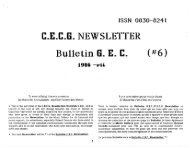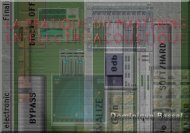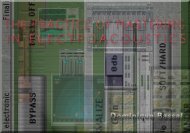The enigma of Vitruvian resonating vases and the relevance ... - CEC
The enigma of Vitruvian resonating vases and the relevance ... - CEC
The enigma of Vitruvian resonating vases and the relevance ... - CEC
Create successful ePaper yourself
Turn your PDF publications into a flip-book with our unique Google optimized e-Paper software.
<strong>The</strong> <strong>enigma</strong> <strong>of</strong> <strong>Vitruvian</strong> <strong>resonating</strong> <strong>vases</strong> <strong>and</strong> <strong>the</strong> <strong>relevance</strong> <strong>of</strong> <strong>the</strong> concept for today - Rob Godman<br />
Page 2 <strong>of</strong> 23<br />
Book 2: Evolution <strong>of</strong> Building, Use <strong>of</strong> materials<br />
Book 3: Ionic Temples<br />
Book 4: Doric <strong>and</strong> Corinthian Temples<br />
Book 5: Public Buildings, <strong>The</strong>atres (<strong>and</strong> music), Baths <strong>and</strong> Harbours<br />
Book 6: Town <strong>and</strong> Country Houses<br />
Book 7: Interior Decoration<br />
Book 8: Water Supply<br />
Book 9: Dials <strong>and</strong> Clocks<br />
Book 10: Mechanical <strong>and</strong> Military Engineering<br />
<strong>The</strong>re are a number <strong>of</strong> surviving manuscripts that have been used to create <strong>the</strong> current published<br />
translations. <strong>The</strong>se date from as early as <strong>the</strong> 8 th Century (London, British Museum). <strong>The</strong> text was<br />
rediscovered in <strong>the</strong> fifteenth century <strong>and</strong> has been studied by renaissance architects to a wider range <strong>of</strong><br />
student in <strong>the</strong> current day. A number <strong>of</strong> translations <strong>of</strong> <strong>the</strong> text exist <strong>and</strong> are available in print. <strong>The</strong> two<br />
used for <strong>the</strong> purpose <strong>of</strong> this paper are:<br />
Vitruvius, <strong>The</strong> Ten Books on Architecture, translated by Morris Hicky Morgon, Dover<br />
Vitruvius, on Architecture, Books I-V <strong>and</strong> Books VI-X, translated by Frank Granger, Loeb<br />
<strong>The</strong> Loeb edition is particularly illuminating as it contains both <strong>the</strong> Latin <strong>and</strong> English translation (needless<br />
to say, issues <strong>of</strong> translation are <strong>of</strong> paramount importance when dealing with technical information from<br />
such an early source). <strong>The</strong> history <strong>of</strong> architectural literature is taken by Vitruvius to begin with <strong>the</strong> <strong>the</strong>atre<br />
<strong>of</strong> Dionysus at A<strong>the</strong>ns.<br />
3. <strong>The</strong>atre design<br />
<strong>The</strong> design <strong>of</strong> a Roman <strong>the</strong>atre has much in common with its Greek counterpart. Before discussing <strong>the</strong><br />
differences it is perhaps worthwhile thinking a little about terminology. It is a common mistake to name<br />
<strong>the</strong> semi-circular Greek <strong>and</strong> Roman <strong>the</strong>atres as amphi<strong>the</strong>atres. <strong>The</strong>y are not! An amphi<strong>the</strong>atre is circular<br />
(think about <strong>the</strong> Coliseum in Rome) <strong>and</strong> a <strong>the</strong>atre is semi-circular (or at least close to it). <strong>The</strong> amphi<strong>the</strong>atre<br />
<strong>and</strong> <strong>the</strong>atre have vastly different uses.<br />
<strong>The</strong> <strong>the</strong>atre <strong>of</strong> <strong>the</strong> Greeks was built on <strong>the</strong> slope <strong>of</strong> a hill, securing sufficient elevation for <strong>the</strong> back row<br />
from <strong>the</strong> naturally occurring l<strong>and</strong>scape. <strong>The</strong> tiers were ei<strong>the</strong>r cut directly into rock or if <strong>the</strong> l<strong>and</strong> was s<strong>of</strong>t an<br />
excavation was made in <strong>the</strong> hillside <strong>and</strong> lined with rows <strong>of</strong> benches. <strong>The</strong> steps were <strong>of</strong>ten faced with<br />
marble (as in <strong>the</strong> <strong>the</strong>atre <strong>of</strong> Dionysus at A<strong>the</strong>ns). <strong>The</strong> <strong>the</strong>atre <strong>of</strong> <strong>the</strong> Romans <strong>and</strong> hence Vitruvius, was<br />
potentially a freest<strong>and</strong>ing structure <strong>and</strong> <strong>the</strong>refore a much more complex design. <strong>The</strong> form <strong>of</strong> <strong>the</strong> Greek <strong>and</strong><br />
Roman <strong>the</strong>atre also differs in terms <strong>of</strong> proportion, as Vitruvius states:








